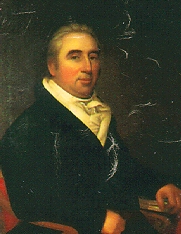William Marbury

William Marbury (November 7, 1762
Background
Marbury, son of William and Martha (Marlowe) Marbury, was born November 7, 1762, in Piscataway, Maryland. He spent most of his early life in Maryland around his home.[3]
Career
Marbury became a
Marbury's suit led to the Supreme Court case
Whilst the case also held that President Adams' signed commissioned in itself "vested a legal right" - that is, legal title - as a Justice of the Peace (implying he was entitled to pay from that date), Marbury never actually exercised that judicial office. Rather he continued a successful career in finance (banking and securities trading).[7] [8]
Personal life
Marbury died on March 13, 1835. He was buried at Oak Hill Cemetery in Washington, D.C.[9]
Legacy
Marbury's former home in Georgetown is now known as "
Descendants include
See also
- Marbury v. Madison
- William L. Marbury, Jr.(probable descendant)
References
- ^ David F. Forte, Marbury's Travail: Federalist Politics and William Marbury's Appointment as Justice of the Peace, Catholic University Law Review, p. 355 Vol 45:349.
- ^ "John Marshall and International Law: Statesman and Chief Justice by Frances Howell Rudko". Archived from the original on 2008-09-27. Retrieved 2017-09-18.
- ^ Forte, David F., "Who was William Marbury?" (2003). Law Faculty Articles and Essays. 66. https://engagedscholarship.csuohio.edu/fac_articles/66
- ^ David F. Forte, Marbury's Travail: Federalist Politics and William Marbury's Appointment as Justice of the Peace, Catholic University Law Review, p. 402 Vol 45:349.
- ^ The Marbury Mystery: Why Did William Marbury Sue in the Supreme Court?
- ^ Treanor, "Judicial Review Before Marbury", 58 Stanford Law Review, p. 458.
- ^ Whatever happened to William Marbury?
- ^ Who Was William Marbury?
- ^ "Oak Hill Cemetery, Georgetown, D.C. (North Hill) - Lot 323" (PDF). Oak Hill Cemetery. Archived (PDF) from the original on 2022-03-02. Retrieved 2022-08-17.
- ^ History of Forrest-Marbury House on the Ukrainian Embassy website.
- ^ David F. Forte, Marbury's Travail: Federalist Politics and William Marbury's Appointment as Justice of the Peace, Catholic University Law Review, p. 350 Vol 45:349.
- ^
ISBN 9780674372955. Retrieved 2 October 2017.
